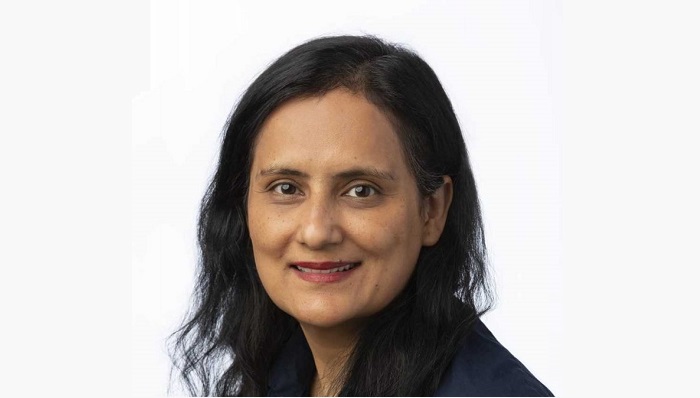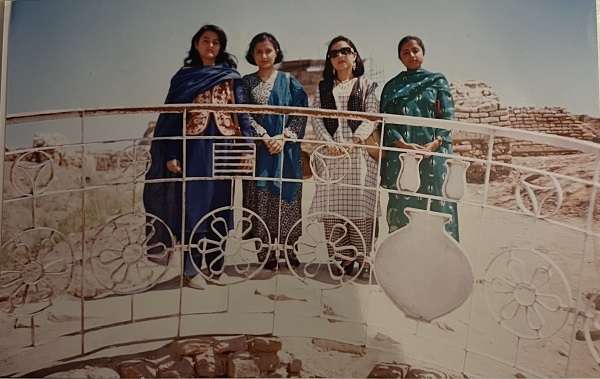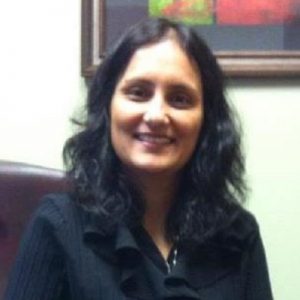The “Home 1947” exhibit, focusing on the partition of South Asia after the departure of the British Empire following a hundred years of rule, premiered on February 22nd, 2024, at the Contemporary Arts Center in Oklahoma City. This significant event of the last century is less well-known in North America, despite the rising South Asian population in the region over the past few decades, and is expected to be 47 million by the year 2060.
I believe this exhibit provides an opportunity for people to build bridges and understand a shared human tragedy. Our future generations must learn about this history, not in an “us versus them” fashion, but as a shared experience. This understanding can help foster empathy and promote unity among diverse communities, which is inherently tied to the continued growth and prosperity of our new home states and countries for the South Asian diaspora.
About ten years ago, I had a conversation with my Mamoo (mom’s brother), Mohammad Rasheed Siddiqui, who will be turning 80 next year in 2025. During our talk, I was captivated by his life journey, starting from North India and his migration to Pakistan during the partition of 1947 with his mother and two brothers, my other uncles Mohammad Habib Siddiqui and Mohammad Mujeeb Siddiqui. Seeing that their generation is aging and passing away, I was concerned that their stories might be lost over time.
I asked him if I could record his interview, but he didn’t feel up to it, and, unfortunately, we never got around to it. I am glad to hear about the Citizens Archives of Pakistan initiated by Shermeen Obaid Chinoy. Others seemed to have similar thoughts and created an organization to preserve these valuable stories. I am grateful to my friend Dr. Nyla Ali Khan for involving me in the advisory committee for this exhibit that debuted in Oklahoma City. I am appreciative of their efforts.
The partition of India marked the division of British India into two independent states, India and Pakistan, at midnight on August 14–15, 1947. This division involved splitting two provinces, Bengal and Punjab, based on district-wise Hindu or Muslim majorities. This created chaos, with people frantically uprooting and moving to their new designated country. The partition was outlined in the Indian Independence Act of 1947 and led to the end of the British Raj, or Crown Rule in India. I often ponder why this major world event did not receive widespread global attention. The only explanation I can fathom is the likelihood that it was embarrassing for the British Empire, which wielded considerable power over the media at the time.
I was deeply moved and overwhelmed with emotion by the pictures, sounds, and stories surrounding the partition. It brought to mind my grandmother, Ayesha Siddiqui, who traveled by train to Sukkur, Sindh, Pakistan, where my grandfather, Haseeb Siddiqui, was stationed as a “Dewan ji” police officer. They were a young married couple with children trying to make a life and survive like any other family. Many did not make it to the other side alive or uninjured, going both ways.
It was moving to hear Dr. Nanda’s story, who was 19 years old at the time of the partition. His family was uprooted from Lyallpur, now known as Faisalabad in Pakistan, to India, where they moved around as refugees. “It was the most painful tragedy of my life. I cannot explain to you guys what we witnessed and experienced. People were traveling on foot, on carts. They were homeless and hungry. We bought 200 cc of milk to make tea for 19 people,” he said.
It’s a stark reminder of how human beings, who are generally good, can do horrific things as part of mad groups. This experience reinforces the importance of passionately building bridges and avoiding being part of hateful discourse. It’s crucial to strive for understanding and empathy, recognizing the shared humanity that binds us all.
I found his contact phone number and called him the next day to invite him to talk about his life journey and the book he had written for his family members after he retired from the University of Oklahoma.
Dr. Udho Thadani was in the audience at the Home 1947 reception. He said he was from Hyderabad, Sind, Pakistan, and his family had to leave home to move to India when he was six. I talked to him after the meeting and told him I grew up in Sindh, where my family had migrated from North India. We were called Hindustani Muhajirs in Pakistan, meaning immigrants or Urdu-speaking people, and treated as outsiders who were taking jobs and college admissions from the indigenous. Habib Mamoo could not get a job in the 1960s as a government officer even after passing the competitive exam because he was not born in Sindh. This is why he left Pakistan to come to the US for a Ph.D. in English literature, becoming one of the very first people from Pakistan to do so. It’s a reminder that prejudice is not just religious.

My mother, Najma Siddiqui, was the only daughter my grandparents had after five boys, and they had spent all of their savings to buy gold jewelry for her to wear head to toe. My nani (maternal grandmother) made a hard decision to sell all of this jewelry to send Habib Mamoo to America for further education.
When I was a small child, I remember asking him how he taught English to Americans on one of his long-awaited journeys back home. “Americans don’t know English,” he said to me. After he came to the US in the 1960s, my grandparents and all other eight siblings of my mother moved here, and they all live here, mainly in Texas.
Prejudice can have many shapes and forms. The separation of East and West Pakistan and the creation of Bangladesh is also a stark reminder of the same reality. The province of Bengal had won the election fair and square, but West Pakistan didn’t let them govern as they believed in their superiority. I encourage the government and the army to learn from our history and refrain from current practices against Balochistan. The US, on the other hand, has its caste system securely in place.
Fortunately for me, I was able to go to the medical college in Larkana in a class full of Sindhi students. It worked out okay for me. I learned medicine and improved my understanding of the Sindhi language. I was able to visit Moen Jo Daro several times. The Moen jo Daro ruins are one of the earliest urban civilizations in the world, existing at the same time as Mesopotamia and Crete. The first great bath, strikingly similar to a modern swimming pool, is located in Moen Jo Daro, which served as a model for similar structures in the later Roman and Greek empires. I made lifelong friends who helped me a lot. I couldn’t have survived without them when I lived in the dorms in Larkana, Pakistan since all of my family had immigrated to Oklahoma.
It was difficult to travel between the two countries, maintain my legal residence status in the US, and stay current with my studies. After the initial hiccup of losing a year, I remained in the top ten of my class when my family moved to the US, and I had to come with them. I guess I was small and appeared innocuous, and they just let me be in Larkana Medical College. However, the Muhajir boys could not attend college. They were run off with threats and violence.
I am thankful to all my friends, especially my roommate, who was like my sister. I wanted us to be sisters forever, but her family rejected my brother’s proposal because we belonged to a different caste.
Many South Asians throughout history embraced Islam and Christianity to escape the caste system of South Asia, but it followed them into their acquired faiths as it is inherent in human societies. Everyone needs someone to look down upon, as Wilkerson aptly put it in her book Caste. Legislators are trying to ban caste discrimination in some states, such as California and Washington. Unfortunately, the affluent and powerful South Asians oppose this ban, citing discrimination and targeting of a specific population.
I called Rasheed Mamoo and enthusiastically told him about the exhibit. I insisted that he should visit the museum to experience it firsthand. During our conversation, I asked him again about his travel during the partition. He shared that they traveled through Rajasthan, which was relatively less dangerous than moving through Punjab, as India and Pakistan share a very long border, and there were several ways to travel. He vividly recalled the moments when the train stopped at rudimentary stations, and how people would try to leave the train in fear as stories of murderous attacks on trains were widespread.
At just four years old, Mamoo Rasheed got trampled and fell over, hitting his head, which left a lesion that took a long time to heal. To this day, he still has a bump on his head, serving as a reminder of their arduous journey. Despite the hardships, he has fond memories of his childhood in India, memories that now feel like a distant dream. Sadly, they were never able to revisit their home. Nana, his father, missed his remaining family back home dearly and often expressed the wish to be buried in his birth town. However, the deteriorating political landscape between the two nations over the years prevented them from returning.

My paternal uncle, Mirza Salamat Baig, was 17 when he boarded a train to Pakistan. He recounted to me a harrowing experience during the journey before he passed away several years ago. There was an announcement on the train instructing all Muslim passengers to move to a special cabin, as everyone appeared ethnically the same and couldn’t easily be distinguished. He told me that, for some reason, he remained frozen in his place and didn’t say anything. Nine men heeded the announcement and moved to the special cabin. Tragically, by the time the train reached its destination, all nine of them were found slaughtered.
The partition of India displaced between 10–15 million people along religious lines, resulting in an overwhelming refugee crisis in the newly created dominions. The violence accompanying or preceding the partition was widespread, with estimates of loss of life varying between several hundred thousand and two million people. This violent upheaval created an atmosphere of hostility and suspicion between India and Pakistan that continues to affect their relationship to the present day.
Over the past 75 years, these two nuclear-armed nations have engaged in three wars over the disputed region of Kashmir. As I write these lines, Kashmir remains one of the most heavily militarized areas in the world, with approximately one military or paramilitary person for every 10 Kashmiri citizens. Tragically, Indians, Pakistanis, and Kashmiris continue to lose their lives over the Line of Control between these rival neighbors to this day. Some scholars and historians fear that the Holocaust is no longer an educating example of never again for humanity and Kashmir is going to be the next Gaza.
The partition had a profound personal impact on both sides of my family. After the partition, my father, Mirza Shujaat Baig, migrated from North India to Pakistan. He arrived in the city of Hyderabad to join his sister and brother-in-law, who had migrated earlier. My father was the youngest of nine children of my grandparents. Two brothers and two sisters also migrated to Pakistan, while the rest of the family stayed behind. My mother, Najma Siddiqui, is the last surviving spouse of this set of siblings. She now lives in Wylie, Texas.
Unfortunately, due to the hostile relations between India and Pakistan, it has become nearly impossible for family members to see each other. The last living sibling of my father recently passed away in Hyderabad, Pakistan, and none of the relatives from India could attend her funeral.
This separation and inability to connect with loved ones across borders continues to be a painful reality for many families affected by the partition. Our future generations must learn about this history, not in an “us versus them” fashion, but as a shared experience. This understanding can help foster empathy and promote unity among diverse communities.
- Home 1947: The Partition of South Asia - 29/02/2024
- Imran Khan and Sharia Law - 06/02/2024
- India: Mosques and Mandirs - 28/01/2024










